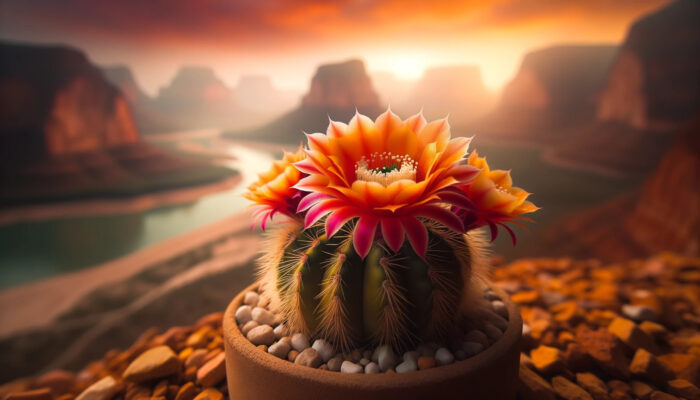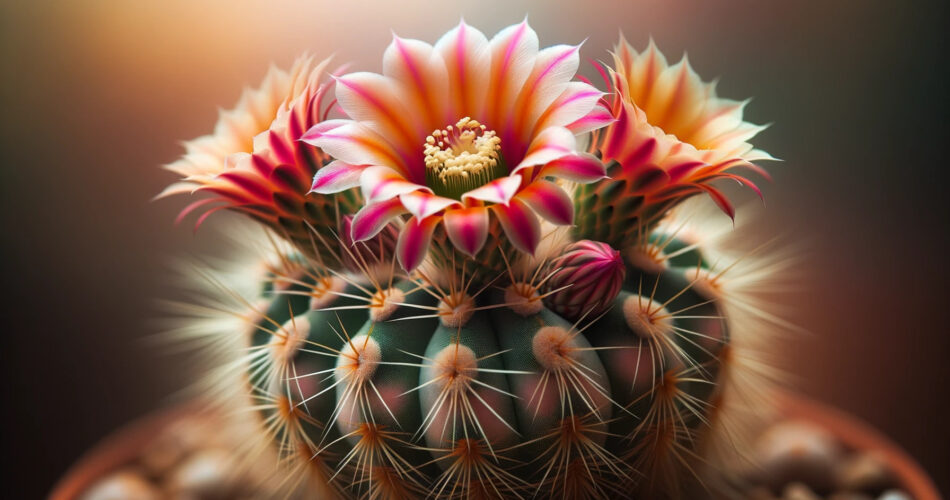Key Takeaways
- Originating from the Andes, Rebutia cacti have evolved to endure high altitudes and vast temperature shifts.
- Their distinct features include a compact form, an ability to store water, and tailored root structures.
- They offer a diverse range of colors, forms, and textures, enhancing the variety in succulent collections.
- For optimal growth, ensure they have porous soil, sufficient light, and a balanced watering routine.
- They can be showcased in glass terrariums, shallow gardens, or paired with other plants.
- Watch out for common issues like mealybugs, scales, mites, and fungal outbreaks.
- Maintain their health by routinely checking for pests, moderating water, and ensuring good airflow.
- Steady growth conditions, temperature and humidity monitoring, and periodic nourishment will help them flourish.
1. The Enchanting Origins of Rebutia Cactus
The world of cacti is full of fascinating plants with unique stories, and Rebutia cacti are no exception. These enchanting succulents originated in the breathtaking landscapes of the Andes, where they have adapted to thrive in the harsh conditions of high altitude and extreme temperature fluctuations.
Uncovering the Secrets of Rebutia’s Andean Ancestry
Rebutia cactus, also known as Crown Cactus, are native to the Andean mountain range, spanning from Bolivia to Argentina. These small, globular cacti have captured the hearts of plant enthusiasts worldwide due to their exquisite beauty and intriguing growth patterns.
Millions of years of evolution have shaped Rebutia cacti into resilient plants that can withstand the harsh Andean climate. The Andes are known for their high elevations, ranging from 8,000 to 22,000 feet, and Rebutia cacti have adapted to survive in these extreme altitudes where other plants struggle to thrive.
These cacti have evolved unique features to survive in the Andean environment, such as their compact size, which helps them endure high winds and extreme temperatures. The natural selection process has favored those Rebutia species that can withstand cold nights and scorching days, making them well suited for cultivation in various climates.
The Unique Adaptations that Make Rebutia Thrive
One of the most captivating features of Rebutia cactus is their ability to produce stunning flowers despite their small size. These flowers, which can be up to 2 inches in diameter, come in a wide range of vibrant colors, including shades of red, pink, orange, and yellow. The vibrant blooms of Rebutia cacti attract pollinators, ensuring their survival and contributing to the biodiversity of their natural habitats.
Another remarkable adaptation of this cactuses is their ability to store water in their thick, fleshy stems. This adaptation allows them to withstand long periods of drought, making them suitable for arid and semi-arid regions. Their water storage capacity also allows them to survive in rocky terrains with minimal soil.
Furthermore, this cacti have developed a specialized root system that enables them to anchor themselves in loose, gravelly soils typical of their native habitats. Their extensive network of fine roots allows them to absorb moisture efficiently, even in the sparsest of environments.
2. The Diverse Variety of Rebutia Cacti
Rebutia cacti come in a staggering variety, displaying an array of colors, shapes, and textures that will captivate any plant lover. Their diversity makes them a popular choice for collectors and enthusiasts looking to expand their succulent collections.
Exploring the Spectrum of Colors in Rebutia Flowers
The flowers of Rebutia exhibit a stunning spectrum of colors, adding a vibrant touch to any garden or indoor display. From fiery reds to delicate pinks and sunny yellows, these charming blooms are a testament to the wonders of nature.
One of the most captivating Rebutia species, Rebutia heliosa, boasts vivid orange flowers that seem to glow like a warm sunset. These radiant blooms are a true standout in any collection and evoke a sense of warmth and joy.
For those who prefer a more classic look, Rebutia violaciflora offers delicate violet-colored flowers, providing an elegant contrast to its green spines. These dainty blooms add a touch of sophistication to any succulent arrangement or garden bed.
From Miniature Marvels to Towering Giants: Rebutia in All Shapes and Sizes
Rebutia cacti showcase an impressive range of sizes, from petite clusters of tiny heads to larger specimen plants that can reach several inches in diameter. These diverse growth habits make them versatile additions to any succulent collection or landscape design.
One fascinating example is Rebutia pygmaea, also known as the King of the Rebutias. As its name suggests, this species is miniature in stature, with individual heads measuring only a few centimeters in diameter. Their compact size makes them ideal for fairy gardens or small indoor arrangements.
On the other end of the spectrum, Rebutia senilis stands out with its larger, cylindrical stems reaching up to 6 inches in height. This towering beauty showcases a cluster of spines that create an eye-catching display, making it a focal point in any cactus garden.
Discover the Fascinating Patterns and Textures of Rebutia Cacti
Rebutia cacti are known for their captivating patterns and textures, which further enhance their allure. From densely packed spines to intricate formations, these unique features provide a visual treat and make them a popular choice among succulent enthusiasts.
One remarkable example is Rebutia minuscula, which boasts numerous golden-yellow spines that tightly encircle each stem. The densely packed spines create a striking texture that adds depth and interest to any succulent collection or rock garden.
Another intriguing species, Rebutia fabrisii, showcases beautifully arranged spines that form distinctive patterns resembling intricate lacework. The delicate web of spines creates a visually stunning effect, often in combination with colorful flowers.

3. Cultivating Rebutia Cacti: Care and Maintenance
Although Rebutia cacti have adapted to survive in extreme conditions, they still require proper care and maintenance when cultivated outside their native habitats. By understanding their preferred growing conditions and following a few essential guidelines, you can ensure the health and longevity of these captivating plants.
Rebutia 101: A Beginners’ Guide to Growing these Captivating Cacti
For beginners venturing into the world of Rebutia cactus cultivation, it is essential to start with healthy plants and provide them with the right growing conditions. Mature, well-established Rebutia specimens are more likely to thrive and adapt to their new environment.
To ensure successful growth, it is vital to choose a well-draining soil mix specially formulated for cacti and succulents. This type of soil prevents waterlogging, which can lead to root rot and other issues. Additionally, providing adequate sunlight and proper watering are crucial factors in Rebutia care.
During the growing season, cacti benefit from bright, indirect sunlight for at least six hours a day. Placing them near a south-facing window or under grow lights will provide the necessary light intensity for optimal growth. However, it is important to protect them from direct sunlight during the hottest hours of the day to prevent sunburn.
Understanding the Preferred Growing Conditions for Rebutia Cacti
In their natural habitat, Rebutia cactus are exposed to a wide range of temperatures, including cool nights and scorching days. Replicating these conditions as closely as possible will help your Rebutia plants thrive.
Rebutia cacti prefer temperatures between 65°F and 80°F (18°C – 27°C) during the growing season. During the winter, they benefit from a cool, dormant period with temperatures around 50°F – 60°F (10°C – 15°C), which promotes flower bud formation and overall health.
These cacti enjoy a relatively drier environment during their dormant period. It is essential to reduce watering frequency and allow the soil to dry out between waterings. However, it is equally important to ensure the soil doesn’t completely dry out, as this can lead to dehydration and wilting.
Nurturing Rebutia Cacti: Pruning, Watering, and Repotting Tips
Proper watering and pruning practices are essential for the well-being of Rebutia cacti. Overwatering can lead to root rot, while underwatering can cause the plants to become dehydrated and weak.
When watering your cacti, it is crucial to find the right balance. As a general rule, water the plants thoroughly when the soil is dry to the touch, taking care not to let water accumulate in the rosette-like centers of the plants, as this can lead to rot. During the winter dormant period, water sparingly, allowing the soil to dry out between waterings.
Pruning Rebutia cacti is not necessary for their overall growth. However, removing dead or damaged stems can improve the appearance and health of the plants. A clean, sharp pair of pruning shears should be used to make precise cuts, ensuring proper healing and minimizing the risk of infection.
Repotting is another important aspect of caring for Rebutia cacti. These plants have shallow root systems and benefit from being repotted every two to three years. When repotting, use a well-draining cactus soil mix and a slightly larger pot to accommodate their growth. Be cautious not to damage the delicate roots during the repotting process.
4. Rebutia: The Crown Jewels of Succulent Collections
Rebutia cacti are prized for their beauty and make stunning additions to succulent collections. Their charming flowers and compact growth habits make them popular choices for enthusiasts and collectors alike.
Creating Stunning Displays with Rebutia Cacti
When planning a display with Rebutia cactus, consider incorporating a variety of species to showcase their diversity. Their vibrant flowers and interesting textures provide an opportunity to create visually stunning arrangements.
One way to create an eye-catching display is by grouping Rebutia species with complementary colors. Pairing contrasting colors, such as orange and blue or pink and green, can create a vibrant and visually appealing arrangement. Additionally, combining species with different growth habits and heights adds depth and dimension to the display.
Showcasing the Beauty of Rebutia in Terrariums and Dish Gardens
Rebutia cactus are well suited for terrariums and dish gardens due to their compact size and low maintenance requirements. A miniature landscape featuring Rebutia cacti can bring a touch of natural beauty to any indoor space.
When creating a terrarium or dish garden, start by selecting a container with proper drainage. Layer the bottom with small stones or activated charcoal to prevent waterlogging. Then, add a layer of well-draining cactus soil mix. Plant the Rebutia cacti, leaving enough space between them to avoid overcrowding.
Finish the arrangement by adding decorative elements such as small rocks, pebbles, or miniature figurines to enhance the aesthetic appeal. Place the terrarium or dish garden in a well-lit area, but avoid direct sunlight to prevent the plants from overheating.
Raising Rebutia: Tips for Combining Complementary Plants
Combining Rebutia cactus with complementary plants can create visually stunning and harmonious compositions. When choosing companion plants, consider their growth habits, water requirements, and light preferences to ensure they are compatible with Rebutia cacti.
Succulents such as Echeveria, Haworthia, and Sedum are excellent choices due to their similar water needs and growth habits. Their plump leaves and unique shapes create an interesting contrast to the spiny stems of the Rebutia cacti.
When pairing Rebutia cactus with other flowering plants, select species that have similar temperature and light requirements. By choosing plants that thrive in similar conditions, you can create a harmonious display that showcases the beauty of both the Rebutia cacti and their floral companions.
5. Common Pests and Diseases: Protecting Your Rebutia Cacti
While Rebutia cacti are generally hardy plants, they are still susceptible to certain pests and diseases. Being vigilant and taking preventative measures can help protect your Rebutia cacti and ensure their long-term health.
Identifying and Treating Pest Infestations in Rebutia Cactus
Common pests that can infest Rebutia cacti include mealybugs, scale insects, and spider mites. These pests can cause damage to the plants by feeding on the sap or leaving behind a sticky residue, leading to fungal infections.
To identify a pest infestation, inspect the stems and undersides of the Rebutia cacti’s spines for signs of pests or webbing. If you notice any pests, gently remove them using a cotton swab dipped in rubbing alcohol or a neem oil-based insecticide spray.
To prevent pest infestations, regularly inspect your Rebutia cacti and neighboring plants. Quarantine new additions to your collection to prevent introducing pests to healthy plants. Additionally, maintaining good airflow and avoiding overwatering can help deter pests, as they thrive in damp conditions.
Preventing and Managing Common Diseases in Rebutia Cactus
Rebutia Cactus are generally hardy and resistant to diseases. However, improper care, overwatering, and poor ventilation can lead to issues such as root rot, fungal infections, or bacterial diseases.
To prevent diseases, ensure proper drainage in the potting mix and avoid leaving the plants in standing water. Water the plants at the soil level, avoiding wetting the stems and rosettes, as excess moisture can promote fungal growth.
If you suspect a disease, promptly remove affected stems or parts and treat the remaining healthy plant with a suitable fungicide or bactericide. Adjust the growing conditions to prevent further spread of the disease, including improving ventilation and reducing watering frequency.

Keeping Your Rebutia Cacti Healthy and Happy in Challenging Conditions
Rebutia cacti are remarkably resilient plants, but they can still face challenges when exposed to unfavorable conditions. Extreme temperature fluctuations, prolonged periods of drought or excessive humidity, and poor soil quality can affect their health and vigor.
To keep your Rebutia cacti healthy and happy, provide them with stable growing conditions as close to their natural habitat as possible. Monitor temperature and humidity levels, ensuring they fall within the ideal range for these cacti.
Avoid sudden temperature changes and protect the plants from frost during the winter months. Implement proper watering practices, allowing the soil to dry out between waterings to prevent root rot while also avoiding dehydration.
Regularly feed your Rebutia cacti with a balanced, diluted fertilizer during the growing season to provide essential nutrients. Choose a fertilizer specifically formulated for cacti and follow the package instructions for best results.
By providing optimal care and being attentive to your Rebutia cacti’s needs, you can enjoy the captivating beauty of these succulents for years to come.
FAQ:
Question: Where do these cacti come from?
Answer: They hail from the Andes, a region that stretches across Bolivia to Argentina.
Question: What features help these cacti survive in their native habitat?
Answer: Their small stature, ability to retain water, and unique roots are key adaptations for thriving in the Andean conditions.
Question: Which flower colors can one expect from these cacti?
Answer: They produce vibrant flowers in shades of red, pink, orange, and yellow.
Question: Are these cacti suitable for container gardens like terrariums?
Answer: Absolutely! Their compact nature and ease of care make them great for terrariums and shallow gardens.
Question: Which pests should I be wary of with these plants?
Answer: Watch out for pests such as mealybugs, scales, and mites.
Question: How can I protect my plants from these pests?
Answer: Keep an eye on your plants, quarantine new ones, ensure they have adequate ventilation, and be cautious with watering to help keep pests at bay.
Question: Are there diseases I should be aware of?
Answer: They can be susceptible to issues like root decay, fungal outbreaks, and certain bacterial ailments.
Question: What care practices will help them thrive?
Answer: Maintain consistent growing conditions, regulate temperature and moisture, and use a nutrient-rich fertilizer for optimal health.




Comments